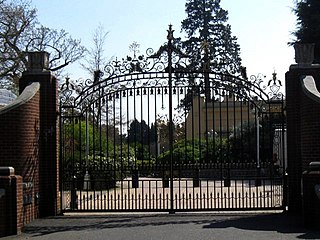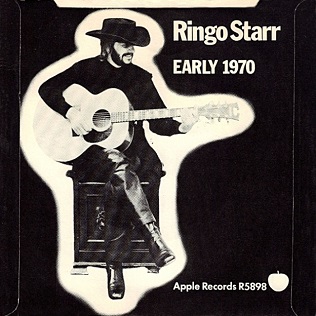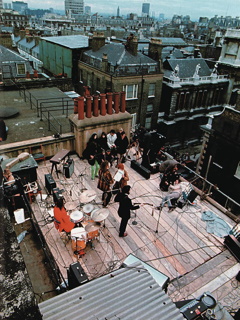
"Get Back" is a song recorded by the English rock band the Beatles and Billy Preston, written by Paul McCartney, and credited to the Lennon–McCartney partnership. It was originally released as a single on 11 April 1969 and credited to "The Beatles with Billy Preston". The song is one of the few examples of John Lennon featuring prominently as lead guitarist. The album version of this song contains a different mix that features a studio chat between Paul McCartney and John Lennon at the beginning, which lasts for 20 seconds before the song begins, also omitting the coda featured in the single version, and with a final dialogue taken from the Beatles' rooftop concert. This version became the closing track of Let It Be (1970), which was released just after the group split up. The single version was later issued on the compilation albums 1967–1970, 20 Greatest Hits, Past Masters, and 1.
Apple Records is a British record label founded by the Beatles in 1968 as a division of Apple Corps Ltd. It was initially intended as a creative outlet for the Beatles, both as a group and individually, plus a selection of other artists including Mary Hopkin, James Taylor, Badfinger and Billy Preston. In practice, the roster had become dominated by the mid-1970s with releases of the former Beatles as solo artists. Allen Klein managed the label from 1969 to 1973, then it was managed by Neil Aspinall on behalf of the Beatles and their heirs. Aspinall retired in 2007 and was replaced by Jeff Jones. Jones stepped down on October 21st, 2024.

Apple Corps Limited is a multi-armed multimedia corporation founded in London in January 1968 by the members of The Beatles to replace their earlier company and to form a conglomerate. The name is a pun for its pronunciation "apple core". Its chief division is Apple Records, which was launched in the same year. Other divisions included Apple Electronics, Apple Films, Apple Publishing and Apple Retail, whose most notable venture was the short-lived Apple Boutique, on the corner of Baker Street and Paddington Street in central London. Apple's headquarters in the late 1960s was at the upper floors of 94 Baker Street, after that at 95 Wigmore Street, and subsequently at 3 Savile Row. The last of these addresses was also known as the Apple Building, which was home to the Apple studio.

The Plastic Ono Band was a rock band and Fluxus-based artist collective formed by John Lennon and Yoko Ono in 1968-9 for their collaborative musical and sound art projects, films, conceptual art projects and eventual solo LPs. The creation of The Plastic Ono Band, which began in 1967 with Ono's idea for an art exhibition in Berlin, allowed Lennon to separate his artistic output from that of The Beatles.

"Come Together" is a song by the British rock band the Beatles, written by John Lennon and credited to Lennon–McCartney. The song is the opening track on the band's 1969 album Abbey Road. It was also a double A-side single in the United Kingdom with "Something", reaching No. 4 in the UK charts.

"Maxwell's Silver Hammer" is a song by the English rock band the Beatles from their 1969 album Abbey Road. It was written by Paul McCartney and credited to the Lennon–McCartney partnership. The song is about a student named Maxwell Edison who commits murders with a hammer, with the dark lyrics disguised by an upbeat sound. McCartney described the song as symbolic of the downfalls of life, being "my analogy for when something goes wrong out of the blue, as it so often does".

"You Know My Name (Look Up the Number)" is a song by the English rock band the Beatles released initially as the B-side of the single "Let It Be" on 6 March 1970. Although first issued with their final single (and the penultimate single in the United States), the Beatles recorded the song in four separate sessions, beginning with three in May and June 1967, during the sessions for Magical Mystery Tour, with one final recording session conducted in April 1969 during the last sessions for Let It Be and Abbey Road. The song features a saxophone part played by Brian Jones of The Rolling Stones.

"The Ballad of John and Yoko" is a song by the English rock band the Beatles that was released as a non-album single in May 1969. It was written by John Lennon and credited to the Lennon–McCartney partnership, and chronicles the events surrounding the wedding of Lennon and Yoko Ono. The song was the Beatles' 17th UK number-one single and their last for 54 years until "Now and Then" in 2023. In the United States, it was banned by some radio stations due to the lyrics' reference to Christ and crucifixion. The single peaked at number 8 on the US Billboard Hot 100. The song has subsequently appeared on compilation albums such as Hey Jude, 1967–1970, Past Masters, and 1.

"Oh! Darling" is a song by the English rock band the Beatles, appearing as the fourth song on their eleventh studio album Abbey Road (1969). It was written primarily by Paul McCartney and credited to Lennon–McCartney. Its working title was "Oh! Darling ". Although not issued as a single in either the United Kingdom or the United States, a regional subsidiary of Capitol successfully edited it as a single in Central America, having "Maxwell's Silver Hammer" as its B-side. It was also issued as a single in Portugal. Apple Records released "Oh! Darling" in Japan with "Here Comes the Sun" in June 1970.

"Dig a Pony" is a song by the English rock band the Beatles from their 1970 album Let It Be. It was written by John Lennon and credited to Lennon–McCartney. The band recorded the song on 30 January 1969, during their rooftop concert at the Apple Corps building on Savile Row in central London.

"Why Don't We Do It in the Road?" is a song by the English rock band the Beatles, released on their 1968 double album The Beatles. Short and simple, it was written and sung by Paul McCartney, but credited to Lennon–McCartney. At 1:42, "Why Don't We Do It in the Road?" comprises 34 bars of a twelve-bar blues idiom. It begins with three different percussion elements and features McCartney's increasingly raucous vocal repeating a simple lyric with only two different lines.

"Everybody's Got Something to Hide Except Me and My Monkey" is a song by the English rock band the Beatles from their 1968 double album The Beatles. It was written by John Lennon and credited to Lennon–McCartney. The lyrics contain sayings the Beatles heard from Maharishi Mahesh Yogi, with whom they studied Transcendental Meditation in India in early 1968. In his subsequent comments on the song, Lennon said it addressed his bandmates' initial reaction to his relationship with Yoko Ono. Recorded early in the sessions for the White Album, the track typifies Lennon and the Beatles' return to a rock sound in 1968 after their psychedelic period.

Tittenhurst Park is a Grade II listed early Georgian country house in Sunningdale near Ascot, Berkshire. It was famously the home of musicians John Lennon and Yoko Ono from 1969 until 1971, and then the home of Ringo Starr and family from 1973 until 1988. Starr sold the property to Sheikh Zayed bin Sultan Al Nahyan, the President of the United Arab Emirates, in 1989.
The Beatles were an English rock band, active from 1960 until 1970. From 1962 onwards, the band's members were John Lennon, Paul McCartney, George Harrison and Ringo Starr. Their break-up is attributed to numerous factors, including: the strain of the Beatlemania phenomenon, the 1967 death of their manager Brian Epstein, bandmates' resentment of McCartney's perceived domineering behaviour, Lennon's heroin use and his relationship with Yoko Ono, Harrison's increasingly prolific songwriting, the floundering of Apple Corps, the Get Back project and managerial disputes.

Let It Be is a 1970 British documentary film starring the Beatles and directed by Michael Lindsay-Hogg. The film documents the group's rehearsing and recording songs in January 1969 for what was to become their twelfth and final studio album Let It Be. The film ends with an unannounced rooftop concert by the group, their last public performance together.
The Apple scruffs were a group of devoted Beatles fans who congregated outside the Apple Corps building and at the gates of Abbey Road Studios in London during the late 1960s, in the hope of seeing or interacting with one of the band members. According to Apple press officer Derek Taylor, when The Sunday Times wrote a feature article on the company in the late 1960s, their map included a location for the scruffs, on the steps of the offices at 3 Savile Row.

"Christmas Time (Is Here Again)" is a Christmas song by the English rock band the Beatles, originally recorded for their fifth fan club Christmas record, Christmas Time Is Here Again! (1967). One of the few Beatles songs credited to all four members of the band, it consists of a blues based backing track as well as double-tracked vocals sung by them, George Martin and Victor Spinetti. The lyrics are mostly made up of the song's title refrain, repeated across nine verses.

"That Means a Lot" is a song written mainly by Paul McCartney, and credited to Lennon–McCartney. It was released in 1965 by P.J. Proby. Proby's version reached #24 on the NME chart. Prior to the release by Proby, the Beatles recorded a version that was intended for the Help! film and soundtrack album. The Beatles were dissatisfied with the song and their version was not released until the Anthology 2 CD in 1996.

"Early 1970" is a song by the English rock musician Ringo Starr that was released as the B-side of his April 1971 single "It Don't Come Easy". A rare example of Starr's songwriting at the time, it was inspired by the break-up of the Beatles and documents his relationship with his three former bandmates. The lyrics to the verses comment in turn on Paul McCartney, John Lennon and George Harrison as individuals, and the likelihood of each of them making music with Starr again. In the final verse, Starr offers a self-deprecating picture of his musical abilities and expresses the hope that all four will play together in the future. Commentators have variously described "Early 1970" as "a rough draft of a peace treaty" and "a disarming open letter" from Starr to Lennon, McCartney and Harrison.

On 30 January 1969, The Beatles performed a concert from the rooftop of their Apple Corps headquarters at 3 Savile Row, in central London's office and fashion district. Joined by guest keyboardist Billy Preston, the band played a 42-minute set before the Metropolitan Police arrived and ordered them to reduce the volume. It was the final public performance of their career. They performed nine takes of five new songs as crowds of onlookers, many on lunch breaks, congregated in the streets and on the rooftops of nearby buildings to listen. The concert ended with "Get Back", and John Lennon joking, "I'd like to say thank you on behalf of the group and ourselves, and I hope we've passed the audition."













